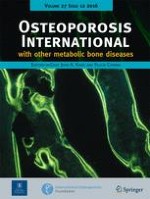Published in:

01-12-2016 | Original Article
Patient-activation and guideline-concordant pharmacological treatment after bone density testing: the PAADRN randomized controlled trial
Authors:
P. Cram, F. D. Wolinsky, Y. Lou, S. W. Edmonds, S. F. Hall, D. W. Roblin, N. C. Wright, M. P. Jones, K. G. Saag, on behalf of the PAADRN Investigators
Published in:
Osteoporosis International
|
Issue 12/2016
Login to get access
Abstract
Summary
Patients often do not know or understand their bone density test results, and pharmacological treatment rates are low. In a clinical trial of 7749 patients, we used a tailored patient-activation result letter accompanied by a bone health brochure to improve appropriate pharmacological treatment. Treatment rates, however, did not improve.
Introduction
Patients often do not know or understand their dual-energy x-ray absorptiometry (DXA) test results, which may lead to suboptimal care. We tested whether usual care augmented by a tailored patient-activation DXA result letter accompanied by an educational brochure would improve guideline-concordant pharmacological treatment compared to usual care only.
Methods
We conducted a randomized, controlled, double-blinded, pragmatic clinical trial at three health care centers in the USA. We randomized 7749 patients ≥50 years old and presenting for DXA between February 2012 and August 2014. The primary clinical endpoint at 12 and 52 weeks post-DXA was receiving guideline-concordant pharmacological treatment. We also examined four of the steps along the pathway from DXA testing to that clinical endpoint, including (1) receiving and (2) understanding their DXA results and (3) having subsequent contact with their provider and (4) discussing their results and options.
Results
Mean age was 66.6 years, 83.8 % were women, and 75.3 % were non-Hispanic whites. Intention-to-treat analyses revealed that guideline-concordant pharmacological treatment was not improved at either 12 weeks (65.1 vs. 64.3 %, p = 0.506) or 52 weeks (65.2 vs. 63.8 %, p = 0.250) post-DXA, even though patients in the intervention group were more likely (all p < 0.001) to recall receiving their DXA results letter at 12 weeks, correctly identify their results at 12 and 52 weeks, have contact with their provider at 52 weeks, and have discussed their results with their provider at 12 and 52 weeks.
Conclusion
A tailored DXA result letter and educational brochure failed to improve guideline-concordant care in patients who received DXA.